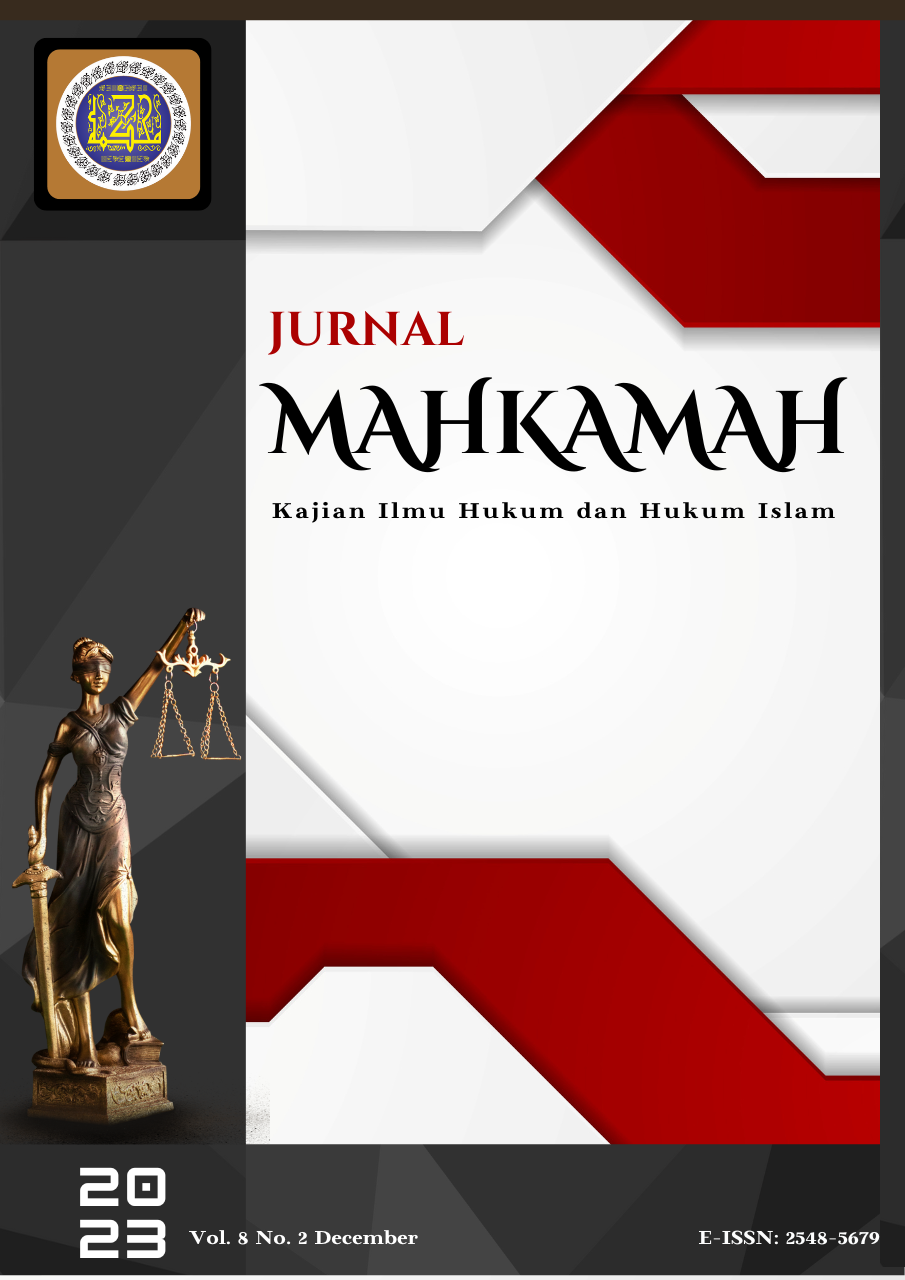Legal Analysis of Incest Marriage in the Suku Anak Dalam (SAD) Community in Rupit District, South Sumatra, Indonesia
DOI:
https://doi.org/10.25217/jm.v8i2.4253Keywords:
Consanguineous Marriages; Inner Tribes; Existence of CustomsAbstract
This article examines incestuous marriage in the Suku Anak Dalam/SAD community from a legal perspective. Juridically, incestuous marriage is prohibited because it negatively affects the risk of children who can experience birth defects and a high risk of death due to lack of genetic variation and a weak immune system. Incest marriages in the SAD community are organised in a hereditary manner that has become a culture. The focus of the study of this article is to find out the reasons why the SAD community conducts incest marriages and how the law views the risks of incest marriages on the children born, especially in the SAD community. The type of research method is qualitative research with a phenomenological approach. This research was conducted in Sungai Jernih Village, Rupit Sub-district, North Musi Rawas Regency, data collection techniques through observation, interviews and documentation, data analysis techniques using an inductive framework with legal theories. The research findings show that one of the factors of incestuous marriage in the SAD community is the strong SAD customs. The Village Government in Sungai Jernih Village, Rupit Sub-district, North Musi Rawas Regency has tried to reach out to the interests of the chief or head of the community group to prevent inbreeding, but this has not been successful because the chief is very concerned with his community and the SAD community strictly adheres to customs. Incestuous marriage, which is still practised in the SAD community, aims to obtain offspring between their tribes and the culture of their ancestors is not lost, this is to continue the offspring so that the existence of SAD is maintained, even though incestuous marriage has a negative impact.
References
Agustin, F. (2018). Kedudukan Anak dari Perkawinan Berbeda Agama Menurut Hukum Perkawinan Indonesia. Ajudikasi: Jurnal Ilmu Hukum, 2(1), 43–54.
Arunde, R. M. M. (2018). Tinjauan Yuridis Tentang Perkawinan Sedarah Menurut UU Nomor 1 Tahun 1974. Lex Privatum, 6(2).
Atmadja, I. D. G. (2018). Asas-asas hukum dalam sistem hukum. Kertha Wicaksana, 12(2), 145–155.
Cahyani, T. D. (2020). Hukum Perkawinan (Vol. 1). UMMPress.
Fuadi, A., Fitriyani, F., Muthahir, A., & Sy, D. A. (2023). Perkawinan Adat Suku Anak Dalam (Sad) Perspektif Uu No. 1 Tahun 1974 Tentang Perkawinan (Studi Kasus Di Kabupaten Musi Rawas Utara Provinsi Sumatera Selatan): Traditional Children Marriage In (Sad) Perspective Law No. 1 Year 1974 Concerning Marriage (Case Study in North Musi Rawas Regency, South Sumatra Province). Jurnal Hadratul Madaniyah, 10(1), 21–29.
Habib, S. A. (2023). Perkawinan Penganut Aliran Penghayat Kepercayaan Di Provinsi Lampung Dan Dampaknya Terhadap Hak Asasi Perempuan Perspektif: Hukum Keluarga Islam Dan Konvensi Internasional. UIN RADEN INTAN LAMPUNG.
Mahendra, I. D. K. I., Sudiatmaka, K., & Sanjaya, D. B. (2022). Implementasi Pasal 8 Undang-Undang No. 1 Tahun 1974 Tentang Perkawinan Terhadap Perkawinan Sedarah (Studi Kasus Di Desa Pelapuan, Busungbiu, Kabupaten Buleleng). Jurnal Komunitas Yustisia, 5(1), 88–100.
Meteng, G. M. (2022). Perkawinan Sedarah Suku Polahi Gorontalo Ditinjau Dari Pasal 8 Undang-Undang Nomor 1 Tahun 1974. Lex Crimen, 10(13).
Mubādalah, I. (n.d.). Discrimination against wife in the perspective of CEDAW and.
Nawawi, A., & Asnawi, H. S. (2022). HEGEMONI PATRIARKHISME Hak Keadilan Perempuan dalam Undang-Undang Perkawinan di Indonesia. The Journal Publishing, 3(9), xxi+-229.
Pratama, F. S., & Hadi, A. A. (2022). Sejarah Dan Perkembangan Kehidupan Suku Anak Dalam Kabupaten Merangin Provinsi Jambi (2011-2019). JAMBE: Jurnal Sejarah Peradaban Islam, 4(1), 14–26.
Rozali, M., & Hikmah, U. (2023). Married ‘Urfi Sheikh Muhammad Ali Jum’Ah’s Thoughts and Their Relevance in the Modern Era. SMART: Journal of Sharia, Tradition, and Modernity, 3(1), 69–82.
Simanjuntak, M. (2008). Selayang Pandang Anak Lintang Bukit Barisan Suku Tobo Atau Kubu. Pematang Siantar: Kolportase Pusat Gereja Kristen Protestan Indonesia.
Waryono, W., Zuhdi, M. N., Nawawi, M. A., & Elmansyah, E. (2021). Islam Rimba: Islamic philosophy and local culture engagement in Sumatera. HTS Teologiese Studies/Theological Studies, 77(4).
Yunus, A. (2020). Hukum Perkawinan dan Itsbat Nikah: Antara Perlindungan dan Kepastian Hukum. Humanities Genius.
Downloads
Published
How to Cite
Issue
Section
License
Copyright (c) 2024 susi kusmawaningsih susi; Anita Mauliyanti; David Kloos; Ari Azhari, Liliany Purnama Ratu

This work is licensed under a Creative Commons Attribution-ShareAlike 4.0 International License.
This work is licensed under a Creative Commons Attribution-ShareAlike 4.0 International License.
Authors retain copyright and grant the Jurnal Mahkamah : Kajian Ilmu Hukum Dan Hukum Islam right of first publication with the work simultaneously licensed under a Creative Commons Attribution License (CC BY-SA 4.0) that allows others to share (copy and redistribute the material in any medium or format) and adapt (remix, transform, and build upon the material) the work for any purpose, even commercially with an acknowledgment of the work's authorship and initial publication in Jurnal Mahkamah : Kajian Ilmu Hukum Dan Hukum Islam.
Authors are able to enter into separate, additional contractual arrangements for the non-exclusive distribution of the journal's published version of the work (e.g., post it to an institutional repository or publish it in a book), with an acknowledgment of its initial publication in Jurnal Mahkamah : Kajian Ilmu Hukum Dan Hukum Islam.
Authors are permitted and encouraged to post their work online (e.g., in institutional repositories or on their website) prior to and during the submission process, as it can lead to productive exchanges, as well as earlier and greater citation of published work (See The Effect of Open Access).








